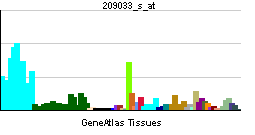DYRK1A
| Dual-specificity tyrosine-(Y)-phosphorylation regulated kinase 1A | |||||||||||
|---|---|---|---|---|---|---|---|---|---|---|---|
| Identifiers | |||||||||||
| Symbols | DYRK1A ; DYRK; DYRK1; HP86; MNB; MNBH | ||||||||||
| External IDs | Template:OMIM5 Template:MGI HomoloGene: 55576 | ||||||||||
| |||||||||||
| RNA expression pattern | |||||||||||
 | |||||||||||
 | |||||||||||
 | |||||||||||
| More reference expression data | |||||||||||
| Orthologs | |||||||||||
| Template:GNF Ortholog box | |||||||||||
| Species | Human | Mouse | |||||||||
| Entrez | n/a | n/a | |||||||||
| Ensembl | n/a | n/a | |||||||||
| UniProt | n/a | n/a | |||||||||
| RefSeq (mRNA) | n/a | n/a | |||||||||
| RefSeq (protein) | n/a | n/a | |||||||||
| Location (UCSC) | n/a | n/a | |||||||||
| PubMed search | n/a | n/a | |||||||||
Dual-specificity tyrosine-(Y)-phosphorylation regulated kinase 1A, also known as DYRK1A, is a human gene.[1]
This gene encodes a member of the Dual-specificity tyrosine phosphorylation-regulated kinase (DYRK) family. This member contains a nuclear targeting signal sequence, a protein kinase domain, a leucine zipper motif, and a highly conservative 13-consecutive-histidine repeat. It catalyzes its autophosphorylation on serine/threonine and tyrosine residues. It may play a significant role in a signaling pathway regulating cell proliferation and may be involved in brain development. This gene is a homolog of Drosophila mnb (minibrain) gene and rat Dyrk gene. It is localized in the Down syndrome critical region of chromosome 21, and is considered to be a strong candidate gene for learning defects associated with Down syndrome. Alternative splicing of this gene generates several transcript variants differing from each other either in the 5' UTR or in the 3' coding region. These variants encode at least five different isoforms.[1]
References
Further reading
- Hämmerle B, Elizalde C, Galceran J; et al. (2004). "The MNB/DYRK1A protein kinase: neurobiological functions and Down syndrome implications". J. Neural Transm. Suppl. (67): 129–37. PMID 15068245.
- Galceran J, de Graaf K, Tejedor FJ, Becker W (2004). "The MNB/DYRK1A protein kinase: genetic and biochemical properties". J. Neural Transm. Suppl. (67): 139–48. PMID 15068246.
- Schultz SJ, Nigg EA (1994). "Identification of 21 novel human protein kinases, including 3 members of a family related to the cell cycle regulator nimA of Aspergillus nidulans". Cell Growth Differ. 4 (10): 821–30. PMID 8274451.
- Shindoh N, Kudoh J, Maeda H; et al. (1996). "Cloning of a human homolog of the Drosophila minibrain/rat Dyrk gene from "the Down syndrome critical region" of chromosome 21". Biochem. Biophys. Res. Commun. 225 (1): 92–9. doi:10.1006/bbrc.1996.1135. PMID 8769099.
- Guimerá J, Casas C, Pucharcòs C; et al. (1997). "A human homologue of Drosophila minibrain (MNB) is expressed in the neuronal regions affected in Down syndrome and maps to the critical region". Hum. Mol. Genet. 5 (9): 1305–10. PMID 8872470.
- Song WJ, Sternberg LR, Kasten-Sportès C; et al. (1997). "Isolation of human and murine homologues of the Drosophila minibrain gene: human homologue maps to 21q22.2 in the Down syndrome "critical region"". Genomics. 38 (3): 331–9. doi:10.1006/geno.1996.0636. PMID 8975710.
- Ohira M, Seki N, Nagase T; et al. (1997). "Gene identification in 1.6-Mb region of the Down syndrome region on chromosome 21". Genome Res. 7 (1): 47–58. PMID 9037601.
- Chen H, Antonarakis SE (1997). "Localisation of a human homologue of the Drosophila mnb and rat Dyrk genes to chromosome 21q22.2". Hum. Genet. 99 (2): 262–5. PMID 9048932.
- Smith DJ, Stevens ME, Sudanagunta SP; et al. (1997). "Functional screening of 2 Mb of human chromosome 21q22.2 in transgenic mice implicates minibrain in learning defects associated with Down syndrome". Nat. Genet. 16 (1): 28–36. doi:10.1038/ng0597-28. PMID 9140392.
- Guimera J, Pritchard M, Nadal M, Estivill X (1997). "Minibrain (MNBH) is a single copy gene mapping to human chromosome 21q22.2". Cytogenet. Cell Genet. 77 (3–4): 182–4. PMID 9284911.
- Dahmane N, Ghezala GA, Gosset P; et al. (1998). "Transcriptional map of the 2.5-Mb CBR-ERG region of chromosome 21 involved in Down syndrome". Genomics. 48 (1): 12–23. doi:10.1006/geno.1997.5146. PMID 9503011.
- Xu X, Rich ES, Seldin DC (1998). "Murine protein kinase CK2 alpha': cDNA and genomic cloning and chromosomal mapping". Genomics. 48 (1): 79–86. doi:10.1006/geno.1997.5154. PMID 9503019.
- Becker W, Weber Y, Wetzel K; et al. (1998). "Sequence characteristics, subcellular localization, and substrate specificity of DYRK-related kinases, a novel family of dual specificity protein kinases". J. Biol. Chem. 273 (40): 25893–902. PMID 9748265.
- Wang J, Kudoh J, Shintani A; et al. (1998). "Identification of two novel 5' noncoding exons in human MNB/DYRK gene and alternatively spliced transcripts". Biochem. Biophys. Res. Commun. 250 (3): 704–10. doi:10.1006/bbrc.1998.9392. PMID 9784410.
- Guimera J, Casas C, Estivill X, Pritchard M (1999). "Human minibrain homologue (MNBH/DYRK1): characterization, alternative splicing, differential tissue expression, and overexpression in Down syndrome". Genomics. 57 (3): 407–18. doi:10.1006/geno.1999.5775. PMID 10329007.
- Hattori M, Fujiyama A, Taylor TD; et al. (2000). "The DNA sequence of human chromosome 21". Nature. 405 (6784): 311–9. doi:10.1038/35012518. PMID 10830953.
- Woods YL, Rena G, Morrice N; et al. (2001). "The kinase DYRK1A phosphorylates the transcription factor FKHR at Ser329 in vitro, a novel in vivo phosphorylation site". Biochem. J. 355 (Pt 3): 597–607. PMID 11311120.
- Mao J, Maye P, Kogerman P; et al. (2002). "Regulation of Gli1 transcriptional activity in the nucleus by Dyrk1". J. Biol. Chem. 277 (38): 35156–61. doi:10.1074/jbc.M206743200. PMID 12138125.
- Strausberg RL, Feingold EA, Grouse LH; et al. (2003). "Generation and initial analysis of more than 15,000 full-length human and mouse cDNA sequences". Proc. Natl. Acad. Sci. U.S.A. 99 (26): 16899–903. doi:10.1073/pnas.242603899. PMID 12477932.
- Martí E, Altafaj X, Dierssen M; et al. (2003). "Dyrk1A expression pattern supports specific roles of this kinase in the adult central nervous system". Brain Res. 964 (2): 250–63. PMID 12576186.
| This article on a gene on human chromosome 21 is a stub. You can help Wikipedia by expanding it. |